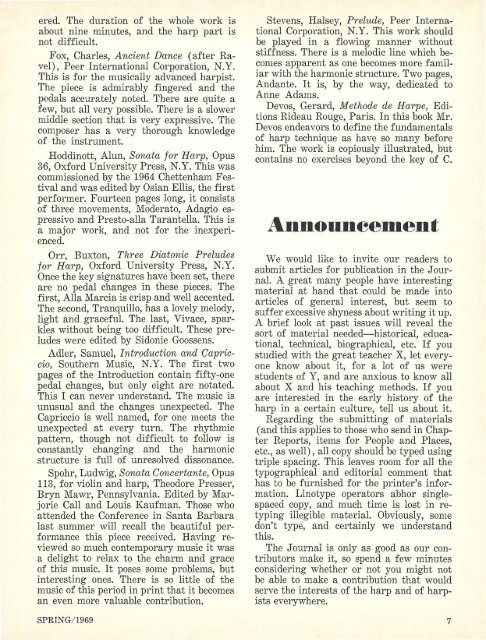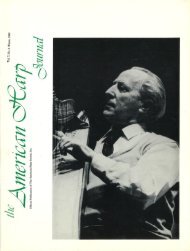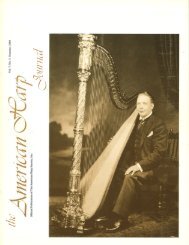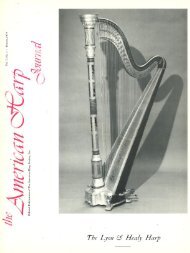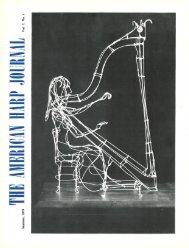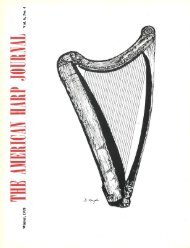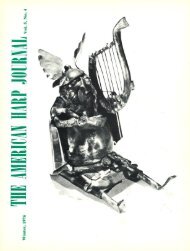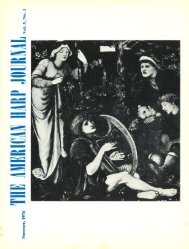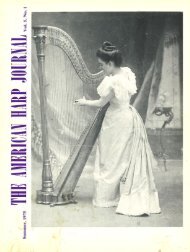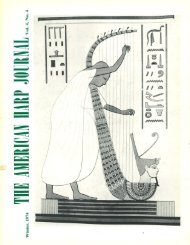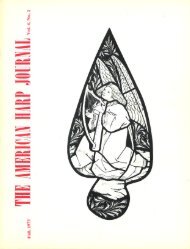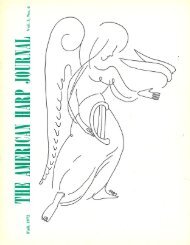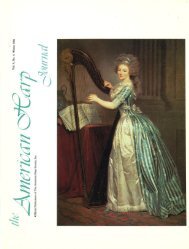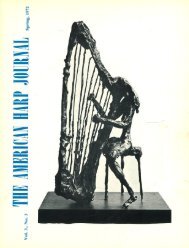AHJ, Vol. 2 No. 1, Spring 1969
AHJ, Vol. 2 No. 1, Spring 1969
AHJ, Vol. 2 No. 1, Spring 1969
You also want an ePaper? Increase the reach of your titles
YUMPU automatically turns print PDFs into web optimized ePapers that Google loves.
ered. The duration of the whole work 1s<br />
about nine minutes, and the harp part 1s<br />
not difficult.<br />
Fox, Charles, Ancient Dance ( after Ravel),<br />
Peer International Coq~oration, N.Y.<br />
This is for the musically advanced harpist.<br />
The piece is admirably fingered and the<br />
pedals accurately noted. There are quite a<br />
few, but all very possible. There is a slower<br />
middle section that is very expressive. The<br />
composer has a very thorough knowledge<br />
of the instrument.<br />
Hoddinott, Alun, Sonata for Harp, Opus<br />
36, Oxford University Press, N.Y. This was<br />
commissioned by the 1964 Chettenham Festival<br />
and was edited by Osian Ellis, the first<br />
performer. Fourteen pages long, it consists<br />
of three movements, Moderato, Adagio espressivo<br />
and Presto-alla Tarantella. This is<br />
a major work, and not for the inexperienced.<br />
Orr, Buxton, Three Diatonic Preludes<br />
for Harp, Oxford University Press, N.Y.<br />
Once the key signatures have been set, there<br />
are no pedal changes in these pieces. The<br />
first, Alla Marcia is crisp and well accented.<br />
The second, Tranquillo, has a lovely melody,<br />
light and graceful. The last, Vivace, sparkles<br />
without being too difficult. These preludes<br />
were edited by Sidonie Goossens.<br />
Adler, Samuel, Introduction and Capriccio,<br />
Southern Music, N.Y. The first two<br />
pages of the Introduction contain fifty-one<br />
pedal changes, but only eight are notated.<br />
This I can never understand. The music is<br />
unusual and the changes unexpected. The<br />
Capriccio is well named, for one meets the<br />
unexpected at every turn. The rhythmic<br />
pattern, though not difficult to follow is<br />
constantly changing and the harmonic<br />
structure is full of unresolved dissonance.<br />
Spohr, Ludwig, Sonata Concertante, Opus<br />
113, for violin and harp, Theodore Presser,<br />
Bryn Mawr, Pennsylvania. Edited by Marjorie<br />
Call and Louis Kaufman. Those who<br />
attended the Conference in Santa Barbara<br />
last summer will recall the beautiful performance<br />
this piece received. Having reviewed<br />
so much contemporary music it was<br />
a delight to relax to the charm and grace<br />
of this music. It poses some problems, but<br />
interesting ones. There is so little of the<br />
music of this period in print that it becomes<br />
an even more valuable contribution.<br />
SPRING/ <strong>1969</strong><br />
Stevens, Halsey, Prelude, Peer International<br />
Corporation, N.Y. This work should<br />
be played in a flowing manner without<br />
stiffness. There is a melodic line which becomes<br />
apparent as one becomes more familiar<br />
with the harmonic structure. Two pages,<br />
Andante. It is, by the way, dedicated to<br />
Anne Adams.<br />
Devos, Gerard, Methode de Harpe, Editions<br />
Rideau Rouge, Paris. In this book Mr.<br />
Devos endeavors to define the fundamentals<br />
of harp technique as have so many before<br />
him. The work is copiously illustrated, but<br />
contains no exercises beyond the key of C.<br />
Anno11neeD1ent<br />
We would like to invite our readers to<br />
submit articles for publication in the Journal.<br />
A great many people have interesting<br />
material at hand that could be made into<br />
articles of general interest, but seem to<br />
suffer excessive shyness about writing it up.<br />
A brief look at past issues will reveal the<br />
sort of material needed-historical, educational,<br />
technical, biographical, etc. If you<br />
studied with the great teacher X, let everyone<br />
know about it, for a lot of us were<br />
students of Y, and are anxious to know all<br />
about X and his teaching methods. If you<br />
are interested in the early history of the<br />
harp in a certain culture, tell us about it.<br />
Regarding the submitting of materials<br />
( and this applies to those who send in Chapter<br />
Reports, items for People and Places,<br />
etc., as well) , all copy should be typed using<br />
triple spacing. This leaves room for all the<br />
typographical and editorial comment that<br />
has to be furnished for the printer's information.<br />
Linotype operators abhor singlespaced<br />
copy, and much time is lost in retyping<br />
illegible material. Obviously, some<br />
don't type, and certainly we understand<br />
this.<br />
The Journal is only as good as our contributors<br />
make it, so spend a few minutes<br />
considering whether or not you might not<br />
be able to make a contribution that would<br />
serve the interests of the harp and of harpists<br />
everywhere.<br />
7


